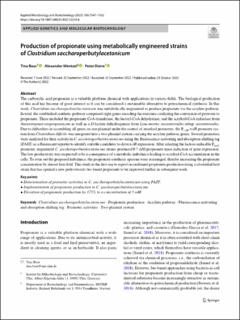| dc.contributor.author | Baur, Tina | |
| dc.contributor.author | Wentzel, Alexander | |
| dc.contributor.author | Dürre, Peter | |
| dc.date.accessioned | 2023-01-09T07:49:27Z | |
| dc.date.available | 2023-01-09T07:49:27Z | |
| dc.date.created | 2022-11-23T17:07:21Z | |
| dc.date.issued | 2022 | |
| dc.identifier.citation | Applied Microbiology and Biotechnology. 2022, 106 (22), 7547-7562. | en_US |
| dc.identifier.issn | 0175-7598 | |
| dc.identifier.uri | https://hdl.handle.net/11250/3041742 | |
| dc.description.abstract | The carboxylic acid propionate is a valuable platform chemical with applications in various fields. The biological production of this acid has become of great interest as it can be considered a sustainable alternative to petrochemical synthesis. In this work, Clostridium saccharoperbutylacetonicum was metabolically engineered to produce propionate via the acrylate pathway. In total, the established synthetic pathway comprised eight genes encoding the enzymes catalyzing the conversion of pyruvate to propionate. These included the propionate CoA-transferase, the lactoyl-CoA dehydratase, and the acryloyl-CoA reductase from Anaerotignum neopropionicum as well as a D-lactate dehydrogenase from Leuconostoc mesenteroides subsp. mesenteroides. Due to difficulties in assembling all genes on one plasmid under the control of standard promoters, the PtcdB-tcdR promoter system from Clostridium difficile was integrated into a two-plasmid system carrying the acrylate pathway genes. Several promoters were analyzed for their activity in C. saccharoperbutylacetonicum using the fluorescence-activating and absorption-shifting tag (FAST) as a fluorescent reporter to identify suitable candidates to drive tcdR expression. After selecting the lactose-inducible PbgaL promoter, engineered C. saccharoperbutylacetonicum strains produced 0.7 mM propionate upon induction of gene expression. The low productivity was suspected to be a consequence of a metabolic imbalance leading to acryloyl-CoA accumulation in the cells. To even out the proposed imbalance, the propionate-synthesis operons were rearranged, thereby increasing the propionate concentration by almost four-fold. This study is the first one to report recombinant propionate production using a clostridial host strain that has opened a new path towards bio-based propionate to be improved further in subsequent work. | en_US |
| dc.language.iso | eng | en_US |
| dc.publisher | Springer | en_US |
| dc.rights | Navngivelse 4.0 Internasjonal | * |
| dc.rights.uri | http://creativecommons.org/licenses/by/4.0/deed.no | * |
| dc.subject | Two-plasmid system | en_US |
| dc.subject | Promoter activities | en_US |
| dc.subject | Fluorescence-activating and absorption-shifting tag | en_US |
| dc.subject | Acrylate pathway | en_US |
| dc.subject | Propionate production | en_US |
| dc.subject | Clostridium saccharoperbutylacetonicum | en_US |
| dc.title | Production of propionate using metabolically engineered strains of Clostridium saccharoperbutylacetonicum | en_US |
| dc.title.alternative | Production of propionate using metabolically engineered strains of Clostridium saccharoperbutylacetonicum | en_US |
| dc.type | Peer reviewed | en_US |
| dc.type | Journal article | en_US |
| dc.description.version | publishedVersion | en_US |
| dc.rights.holder | © The Author(s) 2022 | en_US |
| dc.source.pagenumber | 7547-7562 | en_US |
| dc.source.volume | 106 | en_US |
| dc.source.journal | Applied Microbiology and Biotechnology | en_US |
| dc.source.issue | 22 | en_US |
| dc.identifier.doi | 10.1007/s00253-022-12210-8 | |
| dc.identifier.cristin | 2079490 | |
| dc.relation.project | Norges forskningsråd: 257622 | en_US |
| dc.relation.project | EC/H2020/731101 | en_US |
| dc.relation.project | Norges forskningsråd: 284538 | en_US |
| cristin.ispublished | true | |
| cristin.fulltext | original | |
| cristin.qualitycode | 1 | |

